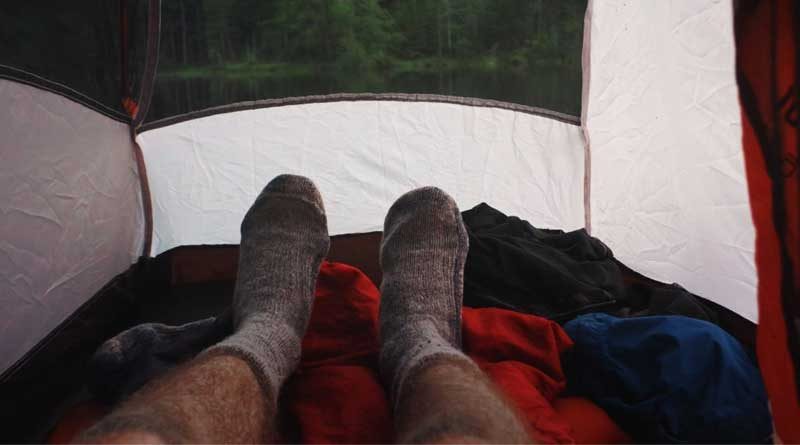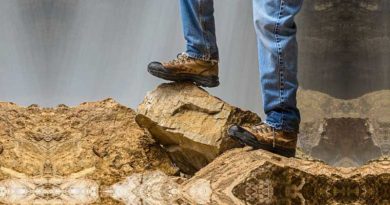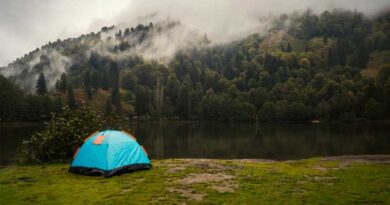8 Effective Ways to Keep Feet Warm in a Sleeping Bag
Keeping your feet warm in a sleeping bag is essential for a good night’s sleep. Because if you think about it, cold feet can be a miserable experience and it’s not just the winter camping but it can also happen during other seasons. Additionally, summer nights can also be pretty chilly when camping in the mountains or at high altitudes. So it’s essential to learn some quick tips to keep your feet nice and toasty. The easiest way to keep your feet warm in a sleeping bag is to use a bottle filled with hot water. This technique works all the time even in the coldest of weather. All you need to do is fill your bottle with boiling water, tighten the lid so it doesn’t leak, and put it into the foot-box of your sleeping bag. This will keep your feet warm and toasty all night long.
1. Use a Hot Water Bottle
As mentioned earlier, this is by far the easiest, most effective, and budget-friendly method. This not only keeps your feet warm but also increases the overall warmth of your sleeping bag. This method is so effective that it works even in the winter. If you don’t have a facility to boil water, this method is not an option for you. In this case, you want to look for some other methods. So keep reading for more tips.
2. Wear Thick Socks
Socks designed for winter camping can add extra warmth to your feet in a sleeping bag. Don’t try to wear multiple pairs of socks and hope for better performance. It just doesn’t work. Always use a single pair of socks with some built-in insulation for better performance. A good example of camping socks to keep your feet toasty is the OHOHAI Thermal Socks.

These socks have 100% goose-down fill and a nylon shell. They are designed to use in sleeping bags for extra warmth for your feet. The shell is also water-resistant and the inside lining feels great against the skin. There’s an elastic band at the ankles that effectively seal out heat and stop the cold wind from blowing into the socks. You can also use these socks outside your sleeping bag during winter camping. It’s always a better idea to pack a pair of these. Also, remember to pack a pair of regular socks in case these thermal socks become too warm for you.
3. Use a Sleeping Bag Liner
A sleeping bag liner is a cocoon-like shaped piece of fabric that goes inside your sleeping bag. It adds about 5 to 10°F of additional warmth to the sleeping bag. If you use a liner, you are going to increase the overall warmth of your sleeping bag, which will ultimately keep you and your feet warm. A liner also keeps your bag from getting dirty. It protects your bag from dirt like sweat, body oils, and hair. Using a liner also increases the life of your bag because you will be washing your sleeping bag less often.

See the Sea to Summit Reactor Thermolite
There are plenty of liner options available but Sea to Summit Reactor Thermolite is what most people use for maximum warmth. It is made of polyester and it weighs around 8 ounces, which is pretty light. This liner is going to add about 15°F of warmth to your sleep system, which is very good if you consider the weight of the liner. If you want even more warmth or you want to convert your 3-season bag into a 4-season, you can use their Reactor PLUS liner that will add around 20°F at a total cost of 9.1 ounces.
4. Use an Insulated Pad
A sleeping pad plays an important role in the overall warmth of your sleep system. If you don’t pay attention to your sleeping pad, you will be cold throughout the night no matter how warm your sleeping bag is. This is because the loft underneath your sleeping bag compresses when you lay in it and provides little to no warmth, so all the insulation from the cold ground will depend on your sleeping pad. If you don’t use an insulated pad, chances are, you will not get enough insulation from the ground. This will make you and your feet cold during the night. So, it’s important to use an insulated sleeping pad to stay warm and comfortable all night long.
5. Go for a Warmer Bag
If you get cold easily during the night, chances are, you need a warmer sleeping bag. This is not an option for you if you already have a sleeping bag. But if you are planning to get a new one and you know you get cold easily during the night, you should consider buying a bag that has a few degrees more warmth. For example, most people use a 20°F bag for 3-season camping but you know you want a little bit more warmth, so in that case, you can opt for a 15°F bag and that will work just fine for you. You can also order a bag with some extra loft in the foot-box. Western Mountaineering makes some great bags with extra fill in the foot-box and it just works great. Remember, you can always increase the warmth of your bag by using a liner.
6. Use more Layers of Clothes
Using more layers of clothes, for example, a base and mid-layer will increase the overall warmth of your body. This is because most vital organs of your body reside in the torso area. If you keep that area warm, it’s going to maintain the overall temperature of your body. It’s always a good idea to wear your mid and base layer before going to sleep.
7. Eat before you sleep
What you eat before you sleep can have a major impact on your sleep. Having a high-calorie meal right before sleeping is a good way of sleeping warm. Make sure you eat the meal at least an hour before you go to bed because once you eat that food, the blood is going to your stomach to digest it. This increases the metabolism of your body, which generates heat. Believe me, if you go to sleep with an empty stomach, you will have a very hard time sleeping warm. Also, foods that take longer to digest such as meat, peanut, nuts, olives, etc. are going to keep you warm much longer.
8. Do Some Exercise
Do some serious exercise before you get in your tent or before you get in your sleeping bag. I know it might be a little annoying to get out of the tent but doing some jumping jacks and pushing your arms around can have a major difference. It feels kind of weird but doing so will get your blood flowing and create heat for your body. If you can’t get outside of your tent, you do some crunches and power lifts and legs; anything to get your muscles heating. It makes a huge difference in staying warm.




